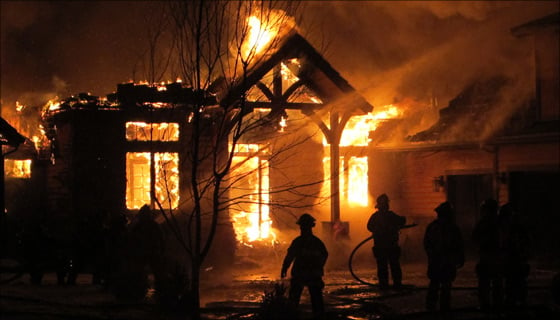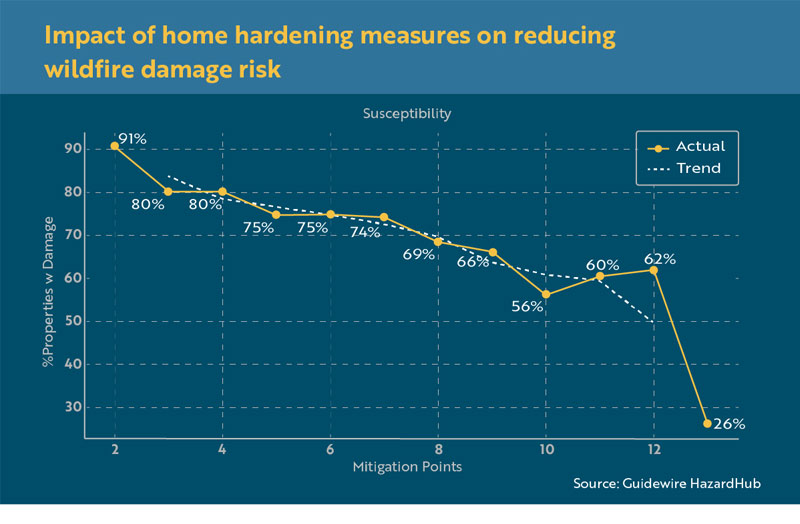
In the face of increasing wildfire risk across the United States, particularly in vulnerable regions like California, understanding the efficacy of mitigation and home-hardening measures has become more critical.
Wildfires threaten lives and prompt states, insurers, and homeowners to turn their attention to mitigation strategies to minimize the destruction caused by these catastrophic events.
Guidewire's HazardHub analyzed historic wildfires and Cal Fire’s Damage Inspection dataset (DINS) to determine the impact of mitigation measures on reducing wildfire damage. The analysis examined data from thousands of home inspections conducted over a decade in California. Drawing on the extensive data from these inspections and fire incident records, the report emphasizes how well-executed mitigation techniques can dramatically reduce both the likelihood and severity of wildfire damage. This blog delves into these findings, underlining the role of data in shaping smarter risk management practices.
The Scope of Wildfire Threats
The intensity and frequency of wildfires have escalated in recent years, fueled by a combination of climate change, forest management practices, and human activity, including population increases and growth in high-risk areas. According to the report, "wildfire risk is highest in states with a high incidence of Wildland Urban Interface (WUI), where homes and natural vegetation intersect." Regions like California and parts of the Pacific Northwest face the greatest threats, with entire communities situated in areas highly susceptible to fire.
This growing threat has forced insurers and policymakers to focus on mitigating risks, spurring efforts to better understand how to minimize potential losses. This is where comprehensive data plays a crucial role, as outlined by HazardHub's study.
Data-Backed Wildfire Mitigation: Insights from 91,800 Home Inspections
One of the most revealing aspects of HazardHub's report is its analysis of data from 91,800 home inspections in California. These inspections form the backbone of the report's findings, revealing the effectiveness of wildfire mitigation measures, especially home hardening. Home hardening refers to specific actions to protect homes from fire, including clearing vegetation, using fire-resistant materials, and installing ember-resistant vents.
The data uncovered significant insights. Homes that incorporated mitigation measures consistently showed a reduction in wildfire risk, both in likelihood and severity of damage. The report noted: "Hardened homes were statistically less likely to ignite compared to those without mitigation efforts." While wildfires are inevitable in some regions, the destruction they cause can be significantly reduced with appropriate measures.
Home Hardening: Key Techniques and Their Impact
HazardHub's report provides a breakdown of various home-hardening techniques that are proving effective in reducing wildfire risk. These include:
- Clearing Defensible Space: One of the most effective measures is creating a defensible space around a property, typically by clearing flammable vegetation. The report highlights that "homes with a well-maintained defensible space are 65% less likely to experience significant damage during a wildfire."
- Fire-Resistant Roofing: Homes with fire-resistant roofing materials, such as metal or Class A shingles, were found to be substantially less likely to ignite during wildfires. The report indicates that "roofing materials are one of the primary determinants in a structure's ability to withstand embers and radiant heat."
- Ember-Resistant Vents: Another crucial mitigation strategy involves the installation of ember-resistant vents. These prevent embers from entering a home through attic or crawl space vents, which can easily lead to ignition. HazardHub's findings reveal that "homes with ember-resistant vents showed a 40% lower likelihood of ignition compared to homes without this feature."
- Fire-Resistant Siding: Using fire-resistant siding materials, such as fiber cement or stucco, further strengthens the home's defenses. "Fire-resistant siding adds an additional layer of protection against flames and radiant heat," the report explains.

Quantifying the Benefits of Mitigation for Insurers
For insurers, the data on mitigation effectiveness is invaluable. It not only helps in more accurately assessing wildfire risk but also allows for better underwriting decisions. The report goes further to explain how regulatory compliance is increasingly tied to mitigation efforts. In California, for instance, stricter building codes and vegetation management requirements have been implemented in high-risk areas. Insurers can leverage the HazardHub data and risk models to ensure they are in line with these evolving regulations, while also offering more competitive pricing for homeowners who take proactive steps to safeguard their properties.
According to the report, "insurers that incorporate wildfire mitigation data into their workflows experience improved underwriting accuracy and loss prediction models." This not only benefits insurers in terms of profitability but also provides a critical incentive for homeowners to adopt mitigation strategies, knowing they will be rewarded with lower premiums.
Understanding the Importance of Multiple Measures
The graph above measures the percentage of homes damaged by wildfires in relation to their resilience scores. Key findings include:
- A resiliency score of 13 can reduce the expected loss by over 70%.
- Homes with a score of eight or more points experience 30% lower damage ratios.
- Adopting just three resiliency points leads to a 20-25% reduction in expected loss compared to properties with no measures.
The study suggests that even one best-practice home hardening measure, combined with an additional effort, can reduce expected damage by approximately 20% or more, while comprehensive measures can decrease risk by up to 74%.
However, multiple actions are necessary for significant protection. The above visualization is intended to help insurers and homeowners understand the critical importance of implementing and maintaining wildfire mitigation strategies. More than one mitigation strategy is required to ensure a property can withstand a wildfire event; multiple actions are needed to achieve significant improvements.
Think of properties with high wildfire risk as a leaking boat: plugging one hole won't significantly reduce the risk of sinking. Only by addressing several leaks can the boat's safety be improved, and plugging all leaks is necessary to eliminate the risk of loss.
Looking Ahead: The Role of Data in Future Wildfire Risk Management
The findings in HazardHub's report also underscore the importance of continued data collection and analysis in wildfire risk management. As wildfire threats continue to grow, so too does the need for accurate, data-driven insights to guide mitigation strategies.
With advanced tools like the HazardHub Enhanced Wildfire Risk Score, both insurers and homeowners are better equipped to understand their risk levels and take the necessary steps to protect their properties.
The data presented in the report paints a clear picture: wildfire mitigation works. By focusing on proven strategies like home hardening, creating defensible space, and utilizing fire-resistant materials, communities can significantly reduce the impact of wildfires. The key moving forward is ensuring that both insurers and homeowners have access to the resources and information they need to implement these life-saving measures.
In a world where wildfires are increasingly unpredictable and destructive, investing in mitigation is not just an option—it's a necessity.